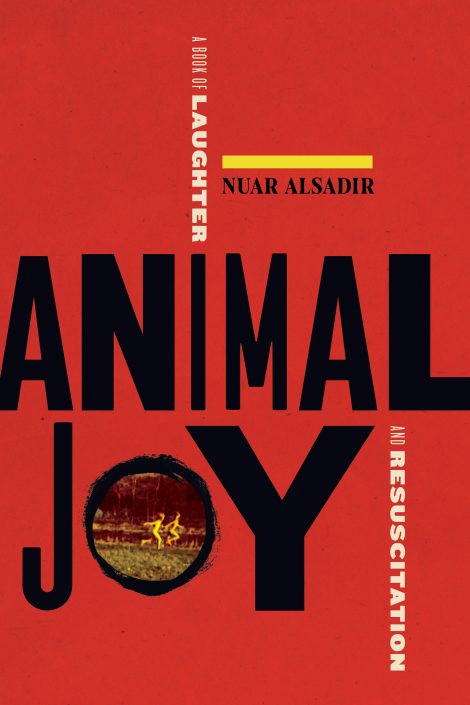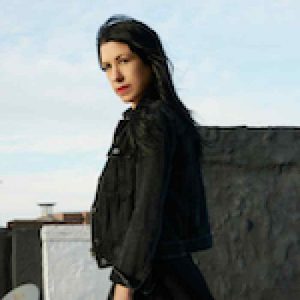
ANIMAL JOY
A Book of Laughter and Resuscitation
Laughter shakes us out of our deadness. An outburst of spontaneous laughter is an eruption from the unconscious that, like political resistance, poetry, or self-revelation, expresses a provocative, impish drive to burst free from external constraints. Taking laughter’s revelatory capacity as a starting point, and rooted in Nuar Alsadir’s experience as a poet and psychoanalyst, Animal Joy seeks to recover the sensation of being present and embodied.
Writing in a poetic, associative style, blending the personal with the theoretical, Alsadir ranges from her experience in clown school, Anna Karenina’s morphine addiction, Freud’s un-Freudian behaviors, marriage brokers and war brokers,
Laughter shakes us out of our deadness. An outburst of spontaneous laughter is an eruption from the unconscious that, like political resistance, poetry, or self-revelation, expresses a provocative, impish drive to burst free from external constraints. Taking laughter’s revelatory capacity as a starting point, and rooted in Nuar Alsadir’s experience as a poet and psychoanalyst, Animal Joy seeks to recover the sensation of being present and embodied.
Writing in a poetic, associative style, blending the personal with the theoretical, Alsadir ranges from her experience in clown school, Anna Karenina’s morphine addiction, Freud’s un-Freudian behaviors, marriage brokers and war brokers, to “Not Jokes,” Abu Ghraib, Fanon’s negrophobia, smut, the Brett Kavanaugh hearings, laugh tracks, the problem with adjectives, and how poetry can wake us up. At the center of the book, however, is the author’s relationship with her daughters, who erupt into the text like sudden, unexpected laughter. These interventions—frank, tender, and always a challenge to the writer and her thinking—are like tiny revolutions, pointedly showing the dangers of being severed from one’s true self and hinting at ways one might be called back to it.
A bold and insatiably curious prose debut, Animal Joy is an ode to spontaneity and feeling alive.
- Graywolf Press
- Paperback
- August 2022
- 296 Pages
- 9781644450932
About Nuar Alsadir
 Nuar Alsadir, a poet and psychoanalyst, is the author of Fourth Person Singular, a finalist for the National Book Critics Circle Award in Poetry and the Forward Prize for Best Collection, and More Shadow Than Bird. She lives in New York City.
Nuar Alsadir, a poet and psychoanalyst, is the author of Fourth Person Singular, a finalist for the National Book Critics Circle Award in Poetry and the Forward Prize for Best Collection, and More Shadow Than Bird. She lives in New York City.
Praise
“Animal Joy jumps for intellectual joy, hopscotching from literary criticism to philosophy and psychology to political analysis. . . . Yet, by sleight of pen, these philosophy-laden pages remain light and graceful. . . . The book is in effect a gift to the courageous. It offers an opportunity for self-reflection and growth. . . . Great art mainly makes you not think but feel. Animal Joy made me do both.” —Melissa Holbrook Pierson, The Washington Post
“Gorgeously written and by turns hilarious and crushing, Alsadir’s examination of humanity’s ‘savage complexity’ is not to be missed.”—Publishers Weekly, starred review
“[Animal Joy] is vulnerable, lyrical, and refreshingly incisive. . . . Alsadir’s quiet wit and depth of knowledge lead to unique insights and profound self-reflection.”—Kirkus Reviews
“Expansive and erudite. . . . Watching the motion of [Alsadir’s] mind across her capacious subject matter is captivating.”—Kathleen Rooney, LIBER Quarterly
“Alsadir’s Granta essay on the emotional flagellation of clowning is one of the best pieces of writing I have ever read, and her longer interrogation into the act—and release—of laughing is equally powerful and moving.”—Courtney Maum, Lit Hub
“Through the awesome and heterogeneous study of this book, laughter at first feels like the most enigmatic act, a convulsing creature in the psyche, in the home, in awkward publics, but then it is returned to us as the most true form of comprehension.”—Holly Pester, author of Comic Timing
Discussion Questions
1. How did Nuar Alsadir’s learn in clown school that she extrapolates into life lessons?
2. What are some of the connections Alsadir draws between clowning, poetry, and psychoanalysis?
3. Did Animal Joy change your perception of laughter? If so, how?
4. Name three or more examples from Animal Joy of how laughter can be a form of resistance.
5. How does Alsadir define the True and False Selves, borrowing from the psychoanalyst Winnicott? What are some of the benefits of being connected to your True Self, and what are some of the dangers in being severed from it?
6. Animal Joy’s subtitle is “A Book of Laughter and Resuscitation.” What does laughter have to do with resuscitation?
7. Alsadir discusses the use of a laugh track and explains how different laugh sounds can be used to manipulate the reaction of an audience. What are some of the examples Alsadir shares of how the laughter of others affects us and how that can be used strategically, not only on television but in the interpersonal and political realms?
8. Animal Joy explores why it is so important to understand what kind of laughter you are hearing. Name 3-5 various types of laughter, as well as their intentions and effects.
9. On page 102, Alsadir defines Duchenne laughter as “spontaneous, body-driven laughter. . . . that often breaks through censors and other inhibitory processes.” Can you give examples from your own experience of this kind of laughter? How frequently do you experience Duchenne laughter and can you notice any commonalities between the contexts in which it erupts?
10. Alsadir’s focus is not only on spontaneous fits of laughter but spontaneous gestures and expressions more broadly. What does Alsadir think we can learn from spontaneous actions—even bungled ones, like slips of the tongue?
11. Other examples in the book come from Alsadir’s experiences with her two daughters. What do children in particular have to teach us about laughter and how it functions?
